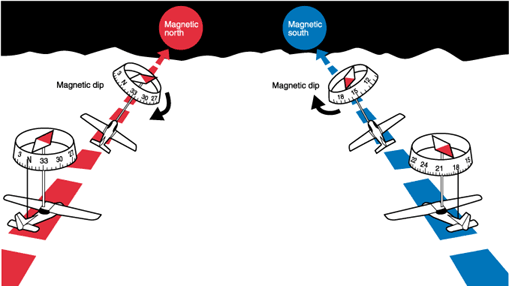
|
In a coordinated turn, the compass, like the occupants of the airplane, feels an effective gravitational force down the vertical axis of the airplane, which banks the compass card with the airplane, out of the horizontal.
Suppose for instance, an airplane (in the Northern Hemisphere) is in a coordinated turn, as illustrated in Figure 2, which depicts the situation where the airplane is currently heading North or South. In each case, because of the dip, the north seeking end of the compass swings downward, so that the compass no longer indicates North or South respectively.
The resulting error, the so-called Northerly Turning Error, depends on the heading, the direction of turn, the angle of bank and the dip angle. One sees from the figure, after some thought, that the error is such that, in a turn the compass leads the airplane on southerly headings and lags on northerly headings1.
On East or West headings2, one can see that there is no error caused by dip.
By calculating the components of the earth's field in the (banked)
plane of the compass, one can derive the relation between compass heading,
![]() , magnetic heading,
, magnetic heading, ![]() , bank angle,
, bank angle, ![]() 3 and dip angle,
3 and dip angle, ![]() 4:
4:
| (2) |
Figure 3 shows the required lead (lag) as a function of magnetic heading, for a sequence of bank angles (0, 10, 20, 30 degrees corresponding to curves A, B, C and D.), computed for a location where the dip is 55 degrees down (typical of mid-latitude US).
For standard rate turns at 100-140 kts, requiring bank angles of 15-20 degrees, we see that the maximum lag or lead is about 20-30 degrees, when the compass heading is approximately North or South, respectively.
This forms the basis for partial panel standard rate turns to a heading in latitudes where the dip angle is not too extreme.5.
The method works best for longer turns where you can get the compass stabilized and where timing turns gets less accurate. It works less well as the required bank angles get steeper and/or the dip angle gets larger, because of the large error that has to be corrected for. For short turns, timing is typically more effective.
For steep turns, where the sum of the dip angle and bank angle exceeds 90 degrees, the compass will ``hang up''. The compass will refuse to turn through 360 degrees as the airplane makes a complete circle.
It's easy to see why. Imagine being on a heading of East in the Northern hemisphere, and gradually increasing bank angle to the right. Initially, the north seeking end of the compass needle will point exactly North, towards the left wing tip. However, as the bank angle increases, a point is reached where the magnetic field becomes parallel to the airplane's vertical axis. Beyond this point, the compass needle will swing 180 degrees to point to the lower, right wingtip and the compass then indicates West instead of East! So it is not quite true to say there is no Northerly turning error on headings of East and West. Beyond the critical bank angle (equal to 90 minus the dip angle), the compass lags by 180 degrees when the airplane is banked toward the equator.
For turns with bank angle exceeding this critical bank angle the compass is close to useless. As an illustration of this, refer to Figure 5 where we plot compass heading versus magnetic heading in a 360 degree right turn.
In curve (A), the bank angle is 20 degrees, less than the critical
![]() degree bank. The compass and magnetic headings
approximately agree, with the compass heading lagging about 30
degrees through North and correspondingly leading through South,
while reading correctly passing through East and West.
degree bank. The compass and magnetic headings
approximately agree, with the compass heading lagging about 30
degrees through North and correspondingly leading through South,
while reading correctly passing through East and West.
In curve (B), the bank angle is now 45 degrees, exceeding the critical 35 degree angle for the 55 degree dip angle. The compass oscillates around 270 while the airplane makes a 360. The compass appears to be mechanically ``stuck'', but in reality its needle is just pointing down towards the low wing, attracted by the downward component of the earth's field. In the limiting case of a 90 degree bank, the compass would indicate 270 degrees throughout the entire turn!